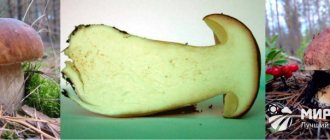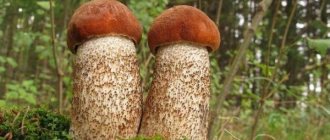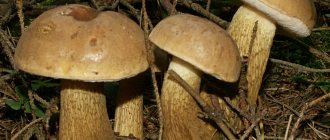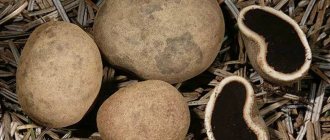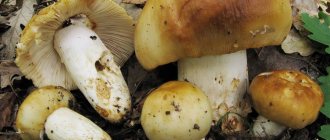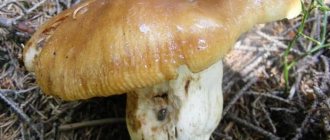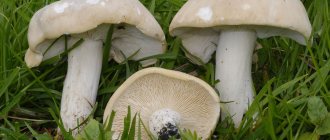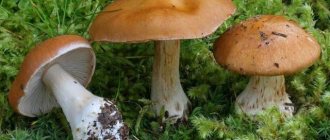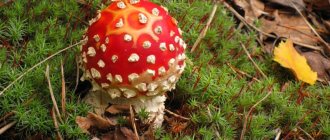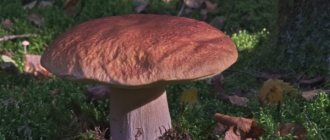Types of Gebelom:
Inedible
Poisonous
Gebeloma adhesive (Valuy false)
Lat:
Hebeloma crustuliniforme
Synonyms:
False valui, Hebeloma crustuliniformis, Horseradish mushroom, Agaricus crustuliniformis, Agaricus ossa, Hylophila crustuliniformis, Hylophila crustuliniformis var crustuliniformis, Hebelomatis crustuliniformis.
Headings: G, Inedible mushrooms, Poisonous mushrooms
Characteristics:
- Group: plate
- Records: free
Inedible
Poisonous
Hebeloma mustard
This is a poisonous species of hebeloma. Their name comes from the fact that when ripe, the plates on the back of the caps acquire a mustard color.
Their caps have wavy edges. They can reach 15 cm in size. The color of the caps varies from cream to brown-red, with the edges being lighter in color than the center. The spore powder is bright orange in color.
The legs are hollow inside; a longitudinal section in their upper part shows the connection between the cavities inside the cap and the leg. The legs are covered with scales in such a way that they create a ring pattern on them.
The favorite place for mustard hebelomas to grow is coniferous and deciduous forests. They grow in numerous groups.
Gebeloma inaccessible
It is a poisonous mushroom.
It has a cap with a diameter of 4 to 8 cm with an indentation in the center. The surface of the cap is mucous, red in color, with a wavy edge. The plates are wide, with light edges. The pulp has a bitter taste and a distinct radish smell. The leg is covered with scales and thickened at the base. They grow in moist soils of coniferous, deciduous and mixed forests, abandoned gardens, and rarely visited corners of parks and squares. Ripen in August-September.
Hebeloma root
Lat:
Hebeloma radicosum
Synonyms:
Hebeloma rhizomatous, Hyfoloma rooted, Hyfoloma rooted, Agaricus radicosus.
Headings: G, Conditionally edible mushrooms
Characteristics:
- Group: plate
- Laminae: fused with a tooth
- Records: free
- with ring
Inedible
Poisonous
Gebeloma coal-loving
Lat:
Hebeloma birrus
Synonyms:
Agaricus birrus, Hylophila birra, Hebeloma birrum, Hebeloma birrum var birrum, Hebeloma birrus, Hebeloma russet.
Headings: G, Inedible mushrooms, Poisonous mushrooms
Conditionally edible
Gebeloma girdled
Lat:
Hebeloma mesophaeum
Synonyms:
Hebeloma brown, Agaricus mesophaeus, Inocybe mesophaea, Hylophila mesophaea, Hylophila mesophaea var mesophaea, Inocybe versipellis var mesophaeus, Inocybe velenovskyi.
Headings: G, Conditionally edible mushrooms
Gebeloma girdled has a dull brown cap, which is noticeably darker in the center than at the edges.
This very common mushroom can be found in various types of forests, as well as in gardens and parks. Characteristics:
- Group: plate
Hebeloma crustuliniforme
Taxonomy:
- Division: Basidiomycota (Basidiomycetes)
- Subdivision: Agaricomycotina (Agaricomycetes)
- Class: Agaricomycetes (Agaricomycetes)
- Subclass: Agaricomycetidae (Agaricomycetes)
- Order: Agaricales (Agaric or Lamellar)
- Family: Hymenogastraceae
- Genus: Hebeloma (Gebeloma)
- Species: Hebeloma crustuliniforme
Valuy is false
- Crust-shaped hebeloma
- Horseradish mushroom
- Agaricus crustuliniformis
- Agaricus ossa
- Hylophila crustuliniformis
- Hylophila crustuliniformis var. crustuliniformis
- Hebelomatis crustuliniformis
Similar species
Hebeloma anthracophilum grows in burnt areas, it is smaller, it has a darker cap and a soft stem.
Hebeloma mesophaeum has a dull brown cap with a darker center and lighter edge, thin flesh in the cap and a thinner stem.
The larger mustard hebeloma (Hebeloma sinapizans) has a cap that is not so slimy and the plates are sparser.
Literatureedit
- Mushrooms: Directory / Translated from Italian F Dvin - M: “Astrel”, “AST”, 2001 - C 157 - ISBN 5-17-009961-4
- Lesso T Mushrooms, key / translated from English by L V Garibova, S N Lekomtseva - M: “Astrel”, “AST”, 2003 - P 67 - ISBN 5-17-020333-0
- Harding P Mushrooms / Translation from English by D S Shchigel - M: “Astrel”, “AST”, 2002 - P 127 - ISBN 5-17-011765-5
- Nilsson, S & Persson, O 1977 Fungi of Northern Europe 2: Gill Fungi Penguin Books English
- Phillips R Mushrooms of North America - Little, Brown & Co, 1991 - ISBN ISBN English
- Serzhanina G I Cap mushrooms of Belarus - Minsk: Science and technology, 1984
gebeloma adhesive paper, gebeloma adhesive tape, gebeloma adhesive film
Description
This is a medium-sized, inedible, cap-shaped mushroom. Painted in light brown and orange shades.
hat
The diameter ranges from 3 to 10 cm, the color is light brown, yellowish. The central part is darker, and the edges are lighter. Sometimes there are caps of rich red, brick colors. The surface is mucous and sticky, which is how hebeloma got its name. In older mushrooms it becomes smooth, glossy and dry.
Records
Fawn, light, with age they turn yellow and become almost brown. They come quite often. The pulp of the hebeloma is white when cut, becoming creamy with age. Quite thick, but the consistency is loose and loose. It has a characteristic bitter taste and emits a rare odor.
Leg
It is from 3 to 10 cm in height, quite large in diameter - up to 2 cm. It is painted in light colors, sometimes yellowish. Cylindrical in shape, expanding towards the base. The pulp is initially dense, but in older representatives the stem becomes hollow.
Spore powder
Orange-brown in color, the spores are shaped like almonds.
Morphology
The fruiting bodies are capped, with a central position of the stem, usually of medium size.
The cap is hemispherical to flat, and may have a tubercle. The skin is slimy or sticky, less often dry, the color is whitish or brown, usually light. The surface is smooth or fibrous, scaly.
The pulp is well developed, fleshy, soft or dense, compact or relatively thin, white or brownish, does not change when cut, is usually bitter and has a strong characteristic odor (rare or other).
The leg is cylindrical, fibrous, may be hollow, often with a scaly or powdery coating.
The plates are adherent, with a notch or free, initially pale, then light brown in color.
The veil is cobwebby or membranous, found in the form of a ring or annular zone on the stalk, hanging flakes along the edge of the cap; in many species these signs are unclearly expressed or completely invisible.
Spore powder of brown-brown shades.
Spreading
It is found everywhere in both coniferous and deciduous forests. It is often found in cities, on private plots, on lawns and in parks. It mainly grows in the temperate climate zone of the northern hemisphere. Also introduced to Australia.
Most often it grows in families, often forming witch circles. This is the name given to one or more rings of mushrooms growing in a clearing.
Fruiting bodies appear at the end of summer, as well as in autumn (until November inclusive).
Taxonomy
Synonyms
:
- Agaricus chrysolithus Batsch 1783, nom. illeg.
- Agaricus leoninus Schaeff. 1774basion
- Agaricus sororiatus P. Karst. 1868
- Pluteus fayodii Damblon, Darimont & Lambinon 1959
- Pluteus flavobrunneus J. Favre 1960, nom. inval.
- Pluteus luteomarginatus Rolland 1889
- Pluteus sororiatus (P. Karst.) P. Karst. 1879 - Pluteus cumulata
Pluteus cumulata
(P. sororiatus
) is considered a synonym, but a number of authors recognize it as an independent species, noting significant differences in both morphological characteristics and ecology. Pluteus luteomarginatus is then considered a synonym for Pluteus cumulata, not lion's yellow.
Homonyms:
- Pluteus leoninus sensu Rea (1922), Cooke is a synonym for Pluteus aurantiorugosus (Trog) Sacc. 1896 - Pluteus orange-wrinkled
- Pluteus leoninus sensu Singer (1930), Imai (1938), Romagn. (1956) is a synonym for Pluteus chrysophaeus (Schaeff.) Quél. 1872 - Pluteus golden-colored
Time and place of fruiting
Gebelomas grow almost everywhere: in deciduous coniferous forests, on forest edges, clearings, in gardens, fields and along roadsides. There is no specific tree under which this mushroom is found; it can be found under oak, aspen, and birch. As for the climate, most often valuu prefers to grow in a cool temperate zone. It is known and avoided in the Far East, the Caucasus, Central Asia and even Australia.
REFERENCE! Mushrooms usually grow not singly, but in groups, and the resulting mycorrhiza binds to the roots of the tree under which they are located. Gebeloma begins to bear fruit in the summer and this continues until November, and if the winter is not cold enough, it continues to grow at this time of year.
How to cook Walui
Have you returned home with a whole basket of weeping eggs and now you don’t know what to do with them? There are many ways to prepare valui. As a result, you will get a tasty and healthy dinner.
Valui hot salted
Hot salted valui is a wonderful appetizer that will delight you and your guests in the winter season.
To prepare you will need:
- 2 kg of mushrooms;
- 150 g salt;
- 11 cloves of garlic;
- 6 buds of cloves;
- two tablespoons of dry dill;
- black or red currant leaves to taste.
If prepared correctly, you will be able to taste salted mushrooms within 2 weeks from the moment the jars are closed.
- So, first prepare the mushrooms. They need to be washed well, cleaned, cut off the stems, and then filled with water and soaked for 2 days. After this time, the mushrooms are boiled in salted water for half an hour. Then they are thrown into a colander and left to drain.
- After the product has dried, the mushrooms are distributed in the jar, but not tightly, so that there is a small space between them. Don't forget to sprinkle each level with a pinch of salt. You can also add your favorite spices to taste.
- Garlic cloves are also distributed between the layers.
- The last layer of mushrooms is generously sprinkled with salt, and currant leaves are laid out on top.
- The top of the mushrooms is covered with gauze and a weight is placed so that the weeping mushrooms can release juice. As soon as the mushrooms settle a little, the brine begins to appear; new mushrooms can be added to the jar, also sprinkled with salt and other spices.
- After closing, the jars should be taken to a cool room and stored for at least 14 days at a temperature not exceeding 10 degrees Celsius.
The pleasant light aroma of garlic upon opening will not leave you indifferent.
Cold-salted Valui
You will need:
- 3 kg of mushrooms;
- 150 g salt;
- 1 teaspoon citric acid;
- 3 teaspoons oregano;
- half a teaspoon of cumin;
- several leaves of horseradish;
- 10 cloves of garlic.
Let's move on to cooking.
- Process the crybaby.
- Place in boiling water.
- Pour citric acid into boiling water and cook for another 20 minutes.
- After this, the mushrooms are placed in a colander.
- Horseradish leaves are placed at the bottom of the jar.
- Next, add mushrooms mixed with garlic. Each layer is sprinkled with spices.
- The contents must be pressed with your hands, then covered with gauze and a weight placed.
- Watch as the mushrooms begin to gradually settle and produce juice over the course of several days.
- Be sure to check for mold. Remove it as it appears. Also change the gauze promptly.
Is horseradish mushroom edible or not?
This type of hebelom, like most others of the same genus, is poisonous. In some sources you can find information that the mushroom is not poisonous, but simply inedible and tasteless. This happens because the toxins contained in the pulp have not yet been studied enough.
The toxicity of value is very high, cases of poisoning are not uncommon. Toxic substances affect the digestive system, nausea, vomiting, diarrhea and colic occur very quickly.
Consumption of gebel can have an effect on the musculoskeletal system, in severe cases leading to paralysis, difficulty breathing and headache. First aid methods for poisoning with this mushroom are not much different from others. You need to rinse your stomach from toxic substances and take any sorbent. You should immediately call a doctor and send the person to the hospital, because the sooner you seek help, the higher the chances of a full recovery.
Edibility
Some sources indicate that this is an inedible mushroom, while others classify it as poisonous. Symptoms of poisoning are typical - vomiting, diarrhea, abdominal pain. They begin to develop 3-4 hours after eating.
Toxicity of Hebeloma adhesive
This is a poisonous mushroom. The toxicity of hebeloma adhesive is extremely high. When poisoned by these mushrooms, after just a few hours, symptoms such as abdominal cramps, vomiting and diarrhea appear. But scientists have not yet been able to identify the toxins that make up Hebeloma adhesive.
Beneficial features
Although many consider valui to be an unworthy, inedible mushroom, when properly prepared, they are not only tasty, but also healthy. The fruiting bodies contain a lot of protein, which gives them healthy nutritional value and makes them suitable for consumption by people who want to lose weight, as well as during intense physical activity. Proteins are close in composition to meat proteins and include essential amino acids - tyrosine, leucine, arginine.
The presence of vitamins and minerals has a positive effect on metabolic processes, the functioning of hematopoietic organs, and the nervous system. The substance ergothioneine is found in tissues, which has pronounced antioxidant properties, inhibits the development of cancer cells, and has an anti-inflammatory and rejuvenating effect.
Moderate inclusion of mushroom dishes in food will help eliminate cholesterol, normalize blood sugar levels, stabilize blood pressure, relieve fatigue syndrome, and give strength and vigor.
False doubles
The adhesive hebeloma has several look-alike species. They all belong to the same genus and are poisonous, inedible:
Coal-loving differs from Sticky hebeloma in its small size, dark color of the cap, and most importantly, it loves to grow in burnt areas of the forest, which is where its name comes from. This species is as poisonous as the sticky one.
The girdled hebeloma has a dark, often brown cap, but its stem is thinner. Unlike hebeloma adhesive and coal-loving, this type of mushroom is not so poisonous. It even has good diuretic and diaphoretic properties, but still it is not worth collecting: it is too similar to its poisonous counterparts. Only an experienced specialist can correctly identify the species.
The mustard plant has sparse plates, the cap is not so sticky, and it is a little larger in size. Toxicity is similar to that of adhesive hebeloma.
There are a number of edible mushrooms that Glutinous Hebeloma is similar to. It is often confused with russula (Rússula) or champignon (Agaricus), as well as valuu (Russula foetens), hence the name of the mushroom - “false valuu”.
True valuu is also called “stinking russula”, and it really belongs to this family, while hebeloma belongs to a completely different genus. Unlike the Valueu, the leg of the hebeloma is covered with scales, while its leg is completely smooth.
Attention! Valuy is bitter and is not eaten abroad. But in our country it is considered conditionally edible; it is usually salted and pickled.
While the forest is warm, the sharp unpleasant smell that distinguishes false valui from noble mushrooms is clearly felt, and mushroom pickers can easily identify the poisonous one. If it starts to get colder in November, then the smell is almost imperceptible, and then you can make a mistake with your choice. Most often this happens to inexperienced mushroom pickers.
Hebeloma anthracophilum
Hebeloma mesophaeum
Hebeloma sinapizans
Russian mustard
- Calorie content: 163.27 kcal
- Carbohydrates: 13.27 g
- Fat: 7.75 g
- Proteins: 8.73 g
The history of Russian mustard begins on the banks of the Sarpa River, where the settlement of the Herrnhuters (followers of the teachings of Jan Hus) of Sarepta was located. It came here along with the seeds of plants brought from India, and at first it was mistaken for a weed, but later it was cultivated and oil and powder began to be produced from mustard seeds. Hence Russian mustard received the name “Sareptskaya”. Its grains range in color from light yellow to brown or gray and have a more pungent taste than the white variety. Russian table seasoning is prepared from mustard powder, or rather from low-fat ground seed cake with the addition of water and vinegar, and is famous for its excellent pungency.
Recipe
To make the seasoning “Russian-style” hot, the powder should be poured with hot water. First, add mustard flour, add water and mix until creamy. Keep in mind that the paste will thicken a little over time. Next, add the remaining ingredients.
For 1 glass of hot liquid:
- 1/2 tbsp. mustard powder;
- 1 tbsp. l. Sahara;
- salt to taste;
- 30 ml vegetable oil;
- 1-2 tbsp. l. vinegar;
- After 12 hours, drain off excess water.
If the powder is fresh, the product is ready for use within a few hours, but it is better to let the product brew. If desired, you can prepare brine for pouring, and here everything depends on your fantasies and taste interests. Some people add cinnamon, while others like the taste of coriander or nutmeg. Everyone will get only “their own burning masterpiece.”
Distinctive features of hebeloma adhesive
The diameter of the cap is 4-9 centimeters. Initially, the shape of the cap is hemispherical, but after some time it becomes rounded-conical, with the edges turned up, after which the cap completely opens and becomes flat.
The surface of the cap is slightly uneven; a small tubercle is visible in the central part. The skin of the cap is smooth and slightly sticky. In mature specimens, the caps dry out and the mucus disappears. The color of the cap is yellow-brown. The edges of the cap are lighter.
The pulp is quite soft and white. It has an unpleasant smell, reminiscent of radishes or raw potatoes, and the taste is bitter. The plates are located frequently. At first they are white, and then become ocher or gray-brown. The edges of the plates are always lighter. Sometimes you can see small transparent droplets on the plates. This clear liquid contains mature pores that produce dark spots when dry. The shape of the spores is almond-shaped. The color of the spore powder is ocher-brown.
The height of the leg is 3-8 centimeters, and the diameter is 1-2 centimeters. The leg is cylindrical in shape, at the base it can be thickened. In mature specimens, the legs are hollow inside. The color of the legs is white or yellow-brown. The upper part of the leg is covered with plaque, which is easily erased.
Variability of Hebeloma adhesive
The peculiarity of this mushroom is that the color of its cap can vary from off-white to nutty and even brick red.
Species differences
The genus Gebelom includes several dozen species. The most common of them in Russia are the following types: sticky, mustard, root, inaccessible, girdled and coal-loving.
Hebeloma adhesive
Mushrooms of this species are the most common hebelomas in our country. Russian mushroom pickers call them "horseradish mushrooms" or false valui, and in England they are called "fairy cake" or "poisoned pie." They are classified as inedible, and in some literary sources - as poisonous mushrooms.
The caps of false value are yellow-brown, sticky in young individuals and dry in mature individuals. The size of the caps of some specimens reaches 10 cm. On the back of the caps, in humid weather, moisture accumulates on the plates, which, after drying, gives them a spotty color. The pulp is light brown with a sharp rare odor and bitter taste.
Sticky mushrooms grow in groups on the edges, clearings, and along roads. Distributed throughout the European part of Russia, the Far East, and Central Asia.
Hebeloma mustard
This is a poisonous species of hebeloma. Their name comes from the fact that when ripe, the plates on the back of the caps acquire a mustard color.
Their caps have wavy edges. They can reach 15 cm in size. The color of the caps varies from cream to brown-red, with the edges being lighter in color than the center. The spore powder is bright orange in color.
The legs are hollow inside; a longitudinal section in their upper part shows the connection between the cavities inside the cap and the leg. The legs are covered with scales in such a way that they create a ring pattern on them.
The favorite place for mustard hebelomas to grow is coniferous and deciduous forests. They grow in numerous groups.
Hebeloma root (root-shaped)
These representatives of the Gebelom genus are conditionally edible: some cooks cook them together with edible mushrooms. The stems of root hebelomas are half immersed in the soil, creating a semblance of a root. Because of this feature, root-type mushrooms got their name.
Their caps are large (up to 15 cm in diameter), hemispherical in shape, and light brown in color. The surface of the cap is covered with darker scales, as a result of which it appears pockmarked. The plates are semi-grown, painted in different shades of gray and brown, while in young specimens they are lighter than in mature ones. The pulp is dense, light, has a bitter taste and almond smell.
They like to grow in deciduous forests because they form mycorrhizae with deciduous trees. More often they can be found in places with bald topsoil: in holes, ditches, near burrows.
Gebeloma inaccessible
It is a poisonous mushroom. It has a cap with a diameter of 4 to 8 cm with an indentation in the center. The surface of the cap is mucous, red in color, with a wavy edge. The plates are wide, with light edges. The pulp has a bitter taste and a distinct radish smell. The leg is covered with scales and thickened at the base.
They grow in moist soils of coniferous, deciduous and mixed forests, abandoned gardens, and rarely visited corners of parks and squares. Ripen in August-September.
Gebeloma girdled
Mushrooms of this species got their name due to the pronounced brown band on the stalk. This girdle is formed by a private veil, which envelops the cap and the upper part of the stem of young specimens, and in mature specimens it remains only in the form of a ring on the stem and scraps along the edge of the cap.
Belted hebelomas are inedible but not poisonous mushrooms. The size of the mushrooms does not exceed 8-9 cm. Their caps come in different shapes: from conical to flat with a tubercle in the center. The surface of the caps is chestnut brown with light edges. The plates are colored pinkish-brown. The pulp is light brown, with the smell of radish.
The leg of the girdled hebeloma is straight or curved, widens towards the base, has white flesh when cut, and brown flesh at the base.
These fungi form mycorrhizae with various deciduous and coniferous trees, so they can often be found under trees.
Gebeloma coal-loving
These are poisonous mushrooms. It is called coal-loving because it grows on the sites of former fires and bonfires. These are small mushrooms, with a cap no more than 2 cm in diameter. Its shape changes as the mushroom matures from dome-shaped to flat. The surface of the cap is slimy to the touch and colored yellow. The plates are brown in color, and the spore powder is bright brown.
The leg is thin, thickened towards the base, covered with a light red coating. The flesh of the mushroom is white, without an unpleasant odor, but with a bitter taste.
The danger of mushrooms
Despite the fact that not all types of hebeloma are poisonous, experienced mushroom pickers and doctors do not recommend eating even their conditionally edible comrades. The explanation for such a negative attitude towards their use in cooking is simple. It lies in the fact that the differences between different types of hebelomas are very insignificant, so conditionally edible mushrooms are very easy to confuse with poisonous specimens. Therefore, in order to avoid acute poisoning by hebel toxins, it is better to avoid collecting and eating them altogether.
Among the various types of these mushrooms, hebeloma mustard, inaccessible and coal-loving can cause acute poisoning. As a rule, there is no lethal outcome when they are consumed by healthy people, but acute digestive and cardiac disorders may occur.
If the victim has severe heart disease, gastrointestinal tract or kidney disease, the use of poisonous hebeloma can provoke a significant deterioration in their health and lead to death as a result of acute failure of the affected organs.
How to get rid of toadstool in the garden?
If a toadstool appears in a garden, vegetable garden or other place on a personal plot, you need to remove it as quickly as possible in order to free the cultivated plants from the unwanted neighborhood. The toadstool must be uprooted and destroyed.
If a group of poisonous mushrooms is found, they should be pulled out. Then, to get rid of the mycelium, lift the top layer of soil and, if possible, remove the mushroom threads. If this is problematic, then leave the layer of earth raised for several days. The sun's rays will completely destroy the remnants of the fungal root system. Then dig up the place where they grew. If there are too many of them, then you will have to fight them with the help of special garden chemicals.
Pale toadstool needs to be uprooted
To prevent the future appearance of green fly agaric in the garden plot, you should clear the area of rotten and rotten wood. It is necessary to periodically remove weeds and tall grass from the area to avoid the appearance of dark, damp areas that poisonous mushrooms love. In those places where toadstool was once found, you need to periodically loosen the soil.
Hebeloma poisoning
The severity of signs of poisoning by poisonous hebelomas depends on the initial state of health of the patient, the amount of mushrooms eaten, and use simultaneously with alcohol, narcotic or potent drugs.
Moderate poisoning is characterized by symptoms:
- nausea;
- vomiting;
- abdominal pain;
- diarrhea;
- an increase in body temperature to subfebrile levels (jet fever);
- dizziness;
- visual disturbances (loss of visual fields, decreased acuity);
- paleness of the skin with cyanosis of the lips and fingertips;
- increased heart rate or heart rhythm disturbances;
- drop in blood pressure;
- severe weakness.
If a small amount of hebeloma is eaten, the patient’s condition may improve on its own after 2-3 days.
In more severe cases, emergency medical attention and hospitalization are required.
First aid
If there is information about the consumption of mushrooms of unknown origin (self-collected, purchased in spontaneous markets), the appearance of the first signs of poisoning (nausea and vomiting) allows one to suspect a person’s poisoning with poisonous mushrooms.
In order not to waste precious time, you must:
- Call an ambulance immediately.
- Induce vomiting in the patient and rinse his stomach.
- Give any intestinal absorbent (activated carbon, Smecta).
- Give (if possible) a cleansing enema to the affected person.
- Save leftover mushrooms or food prepared from them.
- If there are no residues, it is necessary to collect the patient’s vomit in a clean container or plastic bag.
The patient should not take any medications other than absorbents, because this can neutralize the symptoms of poisoning, which will mislead doctors, worsen his condition, or reduce the effectiveness of subsequent drug therapy.
Infection through fresh fruits
Any fruits that have not undergone full pre-treatment (washing with running water with a brush, peeling) and eaten with unwashed hands can lead to dangerous infections. The surface of vegetables or fruits is not sterile; it is actively contaminated upon contact with the ground, microbes multiply on it and there may be parasite eggs. Therefore, the most common disease associated with raw vegetables and fruits is an intestinal infection. The most dangerous microbes will be such microbes as E. coli, staphylococcus, Shigella (the causative agent of dysentery) and many others. Ingestion of the microbe along with food leads to its active reproduction in the intestines and the manifestation of the first symptoms of infection in the form of diarrhea, vomiting, fever and general malaise. However, not only a food infection can be transmitted through vegetables or fruits; the situation is much more serious with hepatitis or Botkin's disease, which also belongs to this category (disease of dirty hands). Its cause is a virus that infects the liver and leads to the development of digestive disorders in combination with jaundice.
Direct salting
So, you have fully prepared molokan mushrooms. How to salt is a separate song, although not too difficult to perform. In the absence of a tub, it is recommended to use an enamel bucket without chips on the inner surface.
Large caps can be cut - purely for ease of use. The mushrooms are layered with halved garlic (about a head will be left), thin circles of horseradish root, lemongrass and black currant leaves, dill seeds (or its umbrellas). Black peppercorns are also acceptable, but not too much. Each layer is sprinkled with a coffee spoon of salt. The top of the bucket is covered with clean gauze, a wide plate and a weight are placed on it - a three-liter bottle of water will be enough. Monitor the condition vigilantly: if mold forms on the gauze, it must be washed. It’s better to replace it with a new one, it’s not that expensive.
Molokankas will be salted from a couple of weeks to a month, depending on the temperature. The warmer the faster, the colder the tastier. It is better to store them cool and eat them like any other salted mushrooms.
“Silent hunting”, starting in the second half of summer (and often earlier), draws crowds of mushroom pickers into the forests. Some already know secret paths and “bread” places, others have just begun to master the subtle science of searching for prey. And such people can easily be misled by molokanka - a mushroom that is similar in appearance to white milk mushroom, but very different from it in taste. And not for the better.
